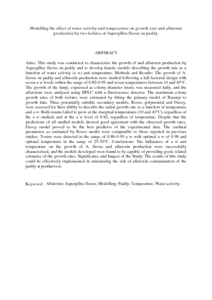Citation
Mousa, Wael and Mohamad Ghazali, Farinazleen and Selamat, Jinap and Mohd Ghazali, Hasanah and Radu, Son
(2011)
Modelling the effect of water activity and temperature on growth rate and aflatoxin production by two isolates of Aspergillus flavus on paddy.
Journal of Applied Microbiology, 111 (5).
pp. 1262-1274.
ISSN 1364-5072
Abstract
Aims: This study was conducted to characterize the growth of and aflatoxin production by Aspergillus flavus on paddy and to develop kinetic models describing the growth rate as a function of water activity (a w) and temperature. Methods and Results: The growth of A. flavus on paddy and aflatoxin production were studied following a full factorial design with seven a w levels within the range of 0·82-0·99 and seven temperatures between 10 and 43°C. The growth of the fungi, expressed as colony diameter (mm), was measured daily, and the aflatoxins were analysed using HPLC with a fluorescence detector. The maximum colony growth rates of both isolates were estimated by fitting the primary model of Baranyi to growth data. Three potentially suitable secondary models, Rosso, polynomial and Davey, were assessed for their ability to describe the radial growth rate as a function of temperature and a w. Both strains failed to grow at the marginal temperatures (10 and 43°C), regardless of the a w studied, and at the a w level of 0·82, regardless of temperature. Despite that the predictions of all studied models showed good agreement with the observed growth rates, Davey model proved to be the best predictor of the experimental data. The cardinal parameters as estimated by Rosso model were comparable to those reported in previous studies. Toxins were detected in the range of 0·86-0·99 a w with optimal a w of 0·98 and optimal temperature in the range of 25-30°C. Conclusions: The influences of a w and temperature on the growth of A. flavus and aflatoxin production were successfully characterized, and the models developed were found to be capable of providing good, related estimates of the growth rates. Significance and Impact of the Study: The results of this study could be effectively implemented in minimizing the risk of aflatoxin contamination of the paddy at postharvest.
Download File
![[img]](http://psasir.upm.edu.my/24103/1.hassmallThumbnailVersion/Modelling%20the%20effect%20of%20water%20activity%20and%20temperature%20on%20growth%20rate%20and%20aflatoxin%20production%20by%20two%20isolates%20of%20Aspergillus%20flavus%20on%20paddy.pdf)  Preview |
|
PDF (Abstract)
Modelling the effect of water activity and temperature on growth rate and aflatoxin production by two isolates of Aspergillus flavus on paddy.pdf
Download (84kB)
| Preview
|
|
Additional Metadata
Actions (login required)
 |
View Item |

